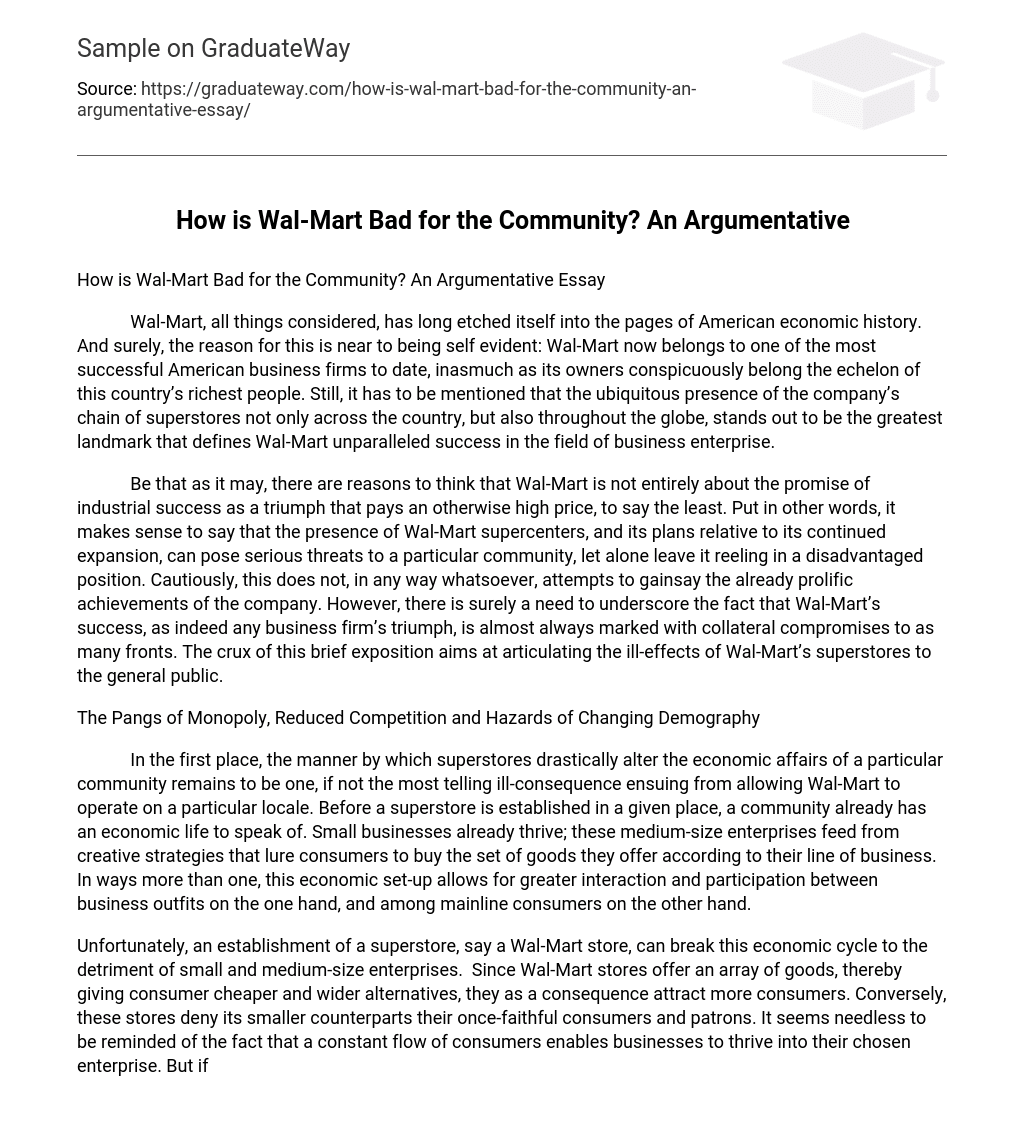Wal-Mart, all things considered, has long etched itself into the pages of American economic history. And surely, the reason for this is near to being self evident: Wal-Mart now belongs to one of the most successful American business firms to date, inasmuch as its owners conspicuously belong the echelon of this country’s richest people. Still, it has to be mentioned that the ubiquitous presence of the company’s chain of superstores not only across the country, but also throughout the globe, stands out to be the greatest landmark that defines Wal-Mart unparalleled success in the field of business enterprise.
Be that as it may, there are reasons to think that Wal-Mart is not entirely about the promise of industrial success as a triumph that pays an otherwise high price, to say the least. Put in other words, it makes sense to say that the presence of Wal-Mart supercenters, and its plans relative to its continued expansion, can pose serious threats to a particular community, let alone leave it reeling in a disadvantaged position. Cautiously, this does not, in any way whatsoever, attempts to gainsay the already prolific achievements of the company. However, there is surely a need to underscore the fact that Wal-Mart’s success, as indeed any business firm’s triumph, is almost always marked with collateral compromises to as many fronts. The crux of this brief exposition aims at articulating the ill-effects of Wal-Mart’s superstores to the general public.
The Pangs of Monopoly, Reduced Competition and Hazards of Changing Demography
In the first place, the manner by which superstores drastically alter the economic affairs of a particular community remains to be one, if not the most telling ill-consequence ensuing from allowing Wal-Mart to operate on a particular locale. Before a superstore is established in a given place, a community already has an economic life to speak of. Small businesses already thrive; these medium-size enterprises feed from creative strategies that lure consumers to buy the set of goods they offer according to their line of business. In ways more than one, this economic set-up allows for greater interaction and participation between business outfits on the one hand, and among mainline consumers on the other hand.
Unfortunately, an establishment of a superstore, say a Wal-Mart store, can break this economic cycle to the detriment of small and medium-size enterprises. Since Wal-Mart stores offer an array of goods, thereby giving consumer cheaper and wider alternatives, they as a consequence attract more consumers. Conversely, these stores deny its smaller counterparts their once-faithful consumers and patrons. It seems needless to be reminded of the fact that a constant flow of consumers enables businesses to thrive into their chosen enterprise. But if Wal-Mart gets to have a lopsided share of consumers, owing much to the sheer massiveness of the goods available in its stock, such an economic alteration could become a sure catalyst for monopoly in trade; and this is not good for the community.
Secondly and along the same vein, there is a need to mention that allowing monopoly to creep into a business environment effectively truncates healthy competition, and thereby depletes the vibrancy of the economic life of a given community. This, in essence, is what John Pelkey attempts to drive home when he said, “Such projects reduce the appraised values of surrounding properties and cause other businesses to suffer or go out of business” (qtd. in Owens). In many ways, a reduced competition within a given economic set-up is bad for the community insofar as it robs them of the chance to work for their fair share of this country’s wealth. Since the presence of Wal-Mart does not even offer a slight avenue for fair and regulated competition, the concept of superstores therefore becomes an enduring testament, nay an unwelcome statement about the unfair trade practices being tolerated across the country.
Thirdly, the hazards of a significantly changed demography appear to be a necessary price attendant to the establishment of Wal-Mart supercenters. Of paramount importance to such observation would be to cite that the dangers which a commercial locale poses to the health and lifestyles of a given community constitute an issue must not be dismissed. When a superstore is erected, it creates ebbs of consequential changes to the life of a community. For once, it generates more concerns relative to an increased human traffic; for where there is a greater concentration of people, the risk involved pertinent to their safety and wellbeing increases. Moreover, extensive traffic problems and “noise pollution” are equally compelling concerns. Last but not least, the “harm” which Wal-Mart poses on “the character of nearby residential neighborhoods” represents a divisive issue not only for the policymakers, but more so for the general public, who are themselves the subject of the demographic change that comes with having to establish a Wal-Mart supercenter (Owen).
Conclusion
By way of conclusion, it must be affirmed that the presence of Wal-Mart is indeed, at least in certain respects, bad for a given community. And there are good reasons to think that the price that needs to be paid by the community in respect to the triumph of Wal-Mart superstores is not a very good testament to the nation’s continued search for equality, fairness and justice. In the discussions that were developed, it was seen that Wal-Mart is essentially a catalyst for monopoly and unfair trade practices. It drives smaller business out of the enterprise and thereby robs the middle class a fair share of this country’s wealth. On top of that, the presence of Wal-Mart poses unmistakable health and lifestyle hazards to an otherwise peaceful neighborhood.
Work Cited
- Owens, D. “Store Plan Draws Rebuke: Council Members Oppose Wal-Mart”. 08 January 2008.
- <http://www.courant.com>





